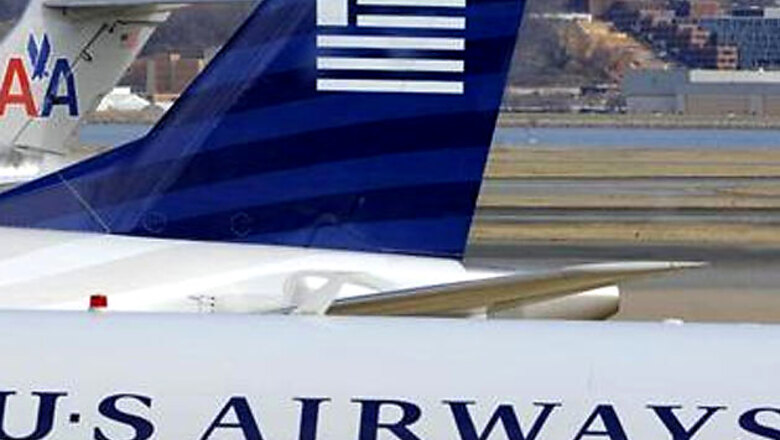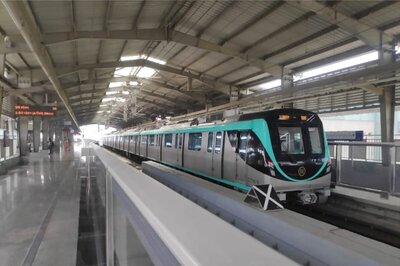
views
AMR Corp and US Airways Group on Thursday unveiled an $11 billion merger deal after months of negotiations, creating the world's biggest airline with 6,700 flights a day.
Now comes the hard part. Before they can welcome their first passenger onboard they have to get regulators to sign off on a deal and then integrate a web of intricate systems - a process that has complicated other marriages in the airline industry.
"So far it's just been pushing paper," said Robert Mann, head of R.W. Mann & Co of Port Washington, New York, which provides industry consulting and analysis. "The next 18 to 24 months is the hard work of implementation."
In addition to integrating the two companies' unionized labor forces, they will need to meld together infrastructure, IT, real estate and commercial systems, he said.
Integrating the airlines' reservations systems is a big challenge, said Basili Alukos, a Morningstar airline analyst. He said the previous US Airways and America West merger was "one of the worst" integrations in the industry, but that US Airways has likely learned from that experience.
"It seems as if (American-US Airways) has the benefit of history on its side," Alukos said, adding that the new American can also learn from the growing pains of Delta-Northwest and United Continental.
United Continental Holdings Inc made a number of changes following its 2010 merger, including converting to a new computer reservation system.
As it shifted to a single reservations system and implemented other new processes, on-time arrivals suffered and mishandled baggage rates went up. United said in January that customer satisfaction scores were improving.
US Airways Chief Executive Doug Parker, who will head the newly merged company, said his experience with America West was a plus.
"Integrating airlines can be difficult sometimes, but we've (already) done one at US Airways," he told Reuters. "We know what to do and know what mistakes to avoid."
Labor integration could also be a challenge for the new American, where union representation issues will need to be resolved.
"The good news is the people they have in the unions now are trying to work with the company," said Darryl Jenkins, chairman of the American Aviation Institute in Washington. "I think they will be able to get through labor issues reasonably quickly now."
All-stock deal
The deal, subject to approvals from US and European regulators the US Bankruptcy Court, gives creditors of the bankrupt American Airlines parent control of the combined airline.
US Air's management team, led by Parker, will assume operational control of the airline, while AMR creditors will wind up owning 72 per cent of the combined carrier and take five seats on the 12-member board.
US Airways will have four seats on the board. The remaining seats will be filled by AMR representatives.
Tom Horton, who became AMR's CEO when it filed for bankruptcy, will serve as chairman of the combined airline through the first annual meeting of shareholders, after which Parker will take over.
"It has been the most successful airline restructuring in history, and we had been very focused from the outset on creating the most value for our owners," Horton told Reuters.
The new combined airline, which will carry the American Airlines name, will be 2 per cent larger than current No. 1 United Continental in terms of traffic - the number of miles flown by paying passengers worldwide.
The merger, could help speed up the recovery of the US airline industry as carriers will have more room to boost fares as yet another competitor is eliminated.
"Wall Street has been enamored of consolidation from an industry perspective because it will help control capacity," said George Hamlin, president of Hamlin Transportation Consulting. "But I'm not sure being large for its own sake is going to guarantee success. A lot of pieces need to be put together. A lot of pieces will need to be shed."
The new American will be based in Dallas-Fort Worth, Texas. Parker has long advocated industry consolidation and began pursuing a merger in early 2012.
Parker, 51, the longest-serving CEO of a major US airline, kick-started the industry's consolidation wave when his America West Holdings bought US Airways out of bankruptcy in 2005.
Horton's role had been one of the last sticking points for a deal, people familiar with the situation said, with AMR's board pushing for a bigger role for him.
"Tom Horton and his team did not want this a few months ago," said Hamlin. "But they are realistic and saw that this is what they needed to do."
The tie-up is the fourth major merger in the US airline industry since 2008, when Delta Air Lines bought Northwest. United and Continental merged in 2010, and Southwest Airlines (LUV.N) bought discount rival AirTran Holdings in 2011.
The new, larger American Airlines would return to the leadership position among US carriers that it ceded in recent years as high labor costs made it difficult to compete with restructured rivals.
The standalone American is currently third in terms of traffic behind United and Delta, both of which used Chapter 11 bankruptcy protection to cut costs and find merger partners.
A combined American-US Airways would have revenue of about $39 billion, based on 2012 figures, ahead of United Continental, which had revenue of about $37 billion.
Deal drivers
US Airways stockholders will receive one share of common stock of the combined airline for each US Airways share, the companies said in a statement.
US Airways shareholders will get 28 per cent of the equity of the combined airline. The remaining 72 per cent will be issuable to stakeholders of AMR and its debtor subsidiaries, American's labor unions and current AMR employees.
"American work groups may be taking a little bit of a pay cut ... (while) US Airways work groups, on the other hand, will probably get a pay raise," Avondale Partners analyst Fred Lowrance said.
Labor unions representing the carriers' pilots, flight attendants and ground service workers said they support the deal, while the machinists union said its renewed contracts must be completed before it supports the merger.
The two companies said they expect $1.2 billion in one-time transition costs, spread over the next three years.
Annual savings from the merger should grow to more than $1 billion by 2015, the companies said.
Rothschild is financial adviser to American Airlines. Weil, Gotshal & Manges LLP, Jones Day, Paul Hastings, Debevoise & Plimpton LLP and K&L Gates LLP are providing legal counsel.
Barclays and Millstein & Co are financial advisers to US Airways, while Latham & Watkins LLP, O'Melveny & Myers, Cadwalader, Wickersham & Taft LLP, and Dechert LLP are serving as legal counsel.
Moelis & Co and Mesirow Financial are financial advisers to the unsecured creditors. Skadden, Arps, Slate, Meagher & Flom LLP and Togut, Segal & Segal LLP are the creditors' legal counsel.
US Airways shares were down 8.6 per cent in mid-afternoon trading to $13.40.
















Comments
0 comment